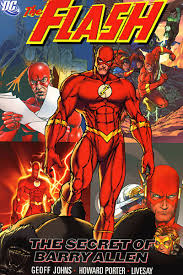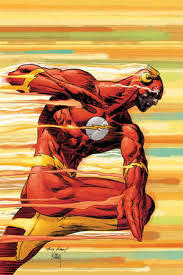Flash
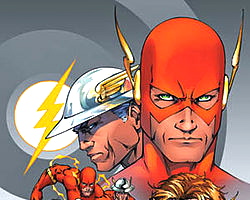
History of The Flash
Today we break down another iconic character, The Flash! Arris goes through the history and some fun facts for this great character.
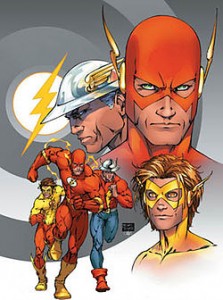 Jay Garrick, Wally West, and Barry Allen on the cover to The Flash (vol. 2) #208. Art by Michael Turner.
Jay Garrick, Wally West, and Barry Allen on the cover to The Flash (vol. 2) #208. Art by Michael Turner.
The Flash is a name shared by several fictional comic book superheroes from theDC Comics universe. Created by writer Gardner Fox and artist Harry Lampert, the original Flash first appeared in Flash Comics #1 (January 1940).
Nicknamed the Scarlet Speedster, all incarnations of the Flash possess “super-speed“, which includes the ability to run and move extremely fast, use superhuman reflexes and seemingly violate certain laws of physics. Thus far, four different characters—each of whom somehow gained the power of “super-speed”—have assumed the identity of the Flash: Jay Garrick (1940–present), Barry Allen (1956–1985, 2008–present), Wally West (1986–2006, 2007–2012), and Bart Allen (2006–2007, 2009–present). Before Wally and Bart’s ascension to the mantle of the Flash, they were both Flash protégés under the same name Kid Flash.
The second incarnation of the Flash, Barry Allen, is generally considered the first hero of the Silver Age of comic books and the superhero has remained one of DC’s most popular ever since. Each version of the Flash has been a key member of at least one of DC’s premier teams: the Justice Society of America, the Justice League, and the Teen Titans. Wally West has recently rejoined the Justice League, and Barry Allen recently returned to life in the pages of Final Crisis.
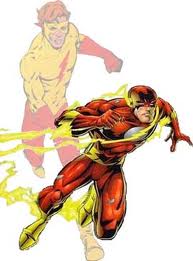 The Barry Allen version of the character (with Wally West elements) was featured in a live action television series in 1990, starring John Wesley Shipp. The Wally West version of the Flash (but with many elements of Barry Allen’s story) is featured in the animated series Justice League. All four incarnations of the character have appeared in the Young Justice animated series, with the Wally West version of Kid Flash as a main character in the first season.
The Barry Allen version of the character (with Wally West elements) was featured in a live action television series in 1990, starring John Wesley Shipp. The Wally West version of the Flash (but with many elements of Barry Allen’s story) is featured in the animated series Justice League. All four incarnations of the character have appeared in the Young Justice animated series, with the Wally West version of Kid Flash as a main character in the first season.
The Flashes have often been close friends with the various men who have been theGreen Lantern; the most notable friendships have been forged between Jay Garrick and Alan Scott (the Golden Age Green Lantern), Barry Allen and Hal Jordan (the Silver Age Green Lantern) and Wally West and Kyle Rayner (the modern Green Lantern), Wally and John Stewart in the Justice League cartoons, as well as Jordan’s friendship with West.
Publication history – Golden Age
The Flash first appeared in the Golden Age Flash Comics #1 (Jan. 1940), from All-American Publications, one of three companies that would eventually merge to form DC Comics. Created by writer Gardner Fox and artist Harry Lampert, this Flash was Jay Garrick, a college student who gained his speed through the inhalation of hard water vapors. When re-introduced in the 1960’s Garrick’s origin was modified slightly, gaining his powers through exposure to heavy water.
Jay Garrick was a popular character in the 1940’s, supporting both Flash Comics and All-Flash Quarterly (later published bi-monthly as simply All-Flash); co-starring in Comic Cavalcade; and being a charter member of the Justice Society of America, the first superhero team, whose adventures ran in All Star Comics. With superheroes’ post-war decline in popularity, Flash Comics was canceled with issue #104 (1949) which featured an Evil version of the Flash called the Rival. The Justice Society’s final Golden Age story ran in All Star Comics #57 (1951; the title itself continued, as All Star Western).
Silver Age
In 1956, DC Comics successfully revived superheroes, ushering in what became known as the Silver Age of comic books. Rather than bringing back the same Golden Age heroes, DC rethought them as new characters for the modern age. The Flash was the first revival, in the aptly named tryout comic book Showcase #4 (Oct. 1956).
This new Flash was Barry Allen, a police scientist who gained super-speed when bathed by chemicals after a shelf of them was struck by lightning. He adopted the name The Flash after reading a comic book featuring the Golden Age Flash. After several more appearances in Showcase, Allen’s character was given his own title, The Flash, the first issue of which was #105 (resuming whereFlash Comics had left off).
The Silver Age Flash proved popular enough that several other Golden Age heroes were revived in new incarnations (see: Green Lantern). A new superhero team, the Justice League of America, was also created, with the Flash as a main, charter member.
Barry Allen’s title also introduced a much-imitated plot device into superhero comics when it was revealed that Garrick and Allen existed on fictional parallel worlds. Their powers allowed them to cross the dimensional boundary between worlds, and the men became good friends. Flash of Two Worlds (The Flash (vol. 1) #123) was the first crossover in which a Golden Age character met a Silver Age character. Soon, there were crossovers between the entire Justice League and the Justice Society; their respective teams began an annual get-together which endured from the early 1960’s until the mid-1980’s.
Allen’s adventures continued in his own title until the advent of Crisis on Infinite Earths. The Flash ended as a series with issue #350. Allen’s life had become considerably confused in the early 1980’s, and DC elected to end his adventures and pass the mantle on to another character. Allen died heroically in Crisis on Infinite Earths #8 (1985). Thanks to his ability to travel through time, he would continue to appear occasionally in the years to come.
The third Flash was Wally West, introduced in The Flash (vol. 1) #110 (Dec. 1959) as Kid Flash. West, Allen’s nephew by marriage, gained the Flash’s powers through an accident identical to Allen’s. Adopting the identity of Kid Flash, he maintained membership in the Teen Titans for years. Following Allen’s death, West adopted the Flash identity in Crisis on Infinite Earths #12 and was given his own series, beginning with The Flash (vol. 2) #1 in 1987. Many issues began with the catchphrase: “My name is Wally West. I’m the fastest man alive.”
Due to the Infinite Crisis miniseries and the “One Year Later” jump in time in the DC Universe, DC canceled The Flash (vol. 2) in January 2006 at #230. A new series, The Flash: The Fastest Man Alive, began on June 21, 2006. The initial story arc of this series, written by Danny Bilson and Paul De Meo with art by Ken Lashley, focused on Bart Allen’s acceptance of the role of the Flash.
Flash: Fastest Man Alive was canceled with issue #13. In its place The Flash (vol. 2) was revived with issue #231, with Mark Waidas the initial writer. Waid also wrote All-Flash #1, which acted as the bridge between the two series. DC had solicited Flash: Fastest Man Alive through issue #15. All Flash #1 replaced issue #14 and The Flash (vol. 2) #231 replaced issue #15 in title and interior creative team only. The covers and cover artists were as solicited by DC, and the information text released was devoid of any plot information.
In 2009, Barry Allen made a full fledged return to the DCU-proper in The Flash: Rebirth, a six-issue miniseries by Geoff Johns and Ethan Van Sciver.
Fictional character biographies
While several other individuals have used the name Flash, these have lived either on other parallel worlds, or in the future. Garrick, Allen and West are the best-known exemplars of the identity.
Jason Peter “Jay” Garrick was a college student in 1938 who accidentally inhaled heavy water vapors after falling asleep in his laboratory where he had been working. As a result, he found that he could run at superhuman speed and had similarly fast reflexes. After a brief career as a college football star, he donned a red shirt with a lightning bolt and a stylized metal helmet with wings (based on images of the Greek deity Hermes), and began to fight crime as the Flash. His first case involved battling the “Faultless Four”, a group of blackmailers. Jay kept his identity secret for years without a mask by continually vibrating his body while in public so that any photograph of his face would be blurred. Although originally from Earth-Two, he was incorporated into the history of New Earthfollowing the Crisis on Infinite Earths and is still active as the Flash operating out of Keystone City. He is a member of the Justice Society.
Bartholomew Henry “Barry” Allen is a police scientist who has a reputation for being very slow, deliberate, and frequently late, which frustrated his fiancée, Iris West. One night, as he was preparing to leave work, a lightning bolt shattered a case full of chemicals and spilled them all over Allen. As a result, Allen found that he could run extremely fast and had matching reflexes. He donned a set of red tights sporting a lightning bolt (reminiscent of the original Fawcett Comics Captain Marvel), dubbed himself the Flash (after his childhood hero, Jay Garrick), and became a crimefighter active in Central City. In his civilian identity, he stores the costume compressed in a special ring via the use of a special gas that could compress cloth fibers to a very small fraction of their normal size.
Allen sacrificed his life for the universe in the 1985 maxi-series Crisis on Infinite Earths, and remained dead for over twenty years after that story’s publication. With the 2008 series Final Crisis, Allen returned to the DC Universe and returned to full prominence as the Flash in the 2009 series The Flash: Rebirth, which was soon after followed by a new volume of The Flash ongoing series, where Allen’s adventures as the Scarlet Speedster are currently published.
Wallace Rudolph “Wally” West is the nephew of Iris West and of Barry Allen by marriage, and was introduced in The Flash (vol. 1) #110 (1959). When West was about ten years old, he was visiting his uncle’s police laboratory, and the freak accident that gave Allen his powers repeated itself, bathing West in electrically charged chemicals. Now possessing the same powers as his uncle, West donned a copy of his uncle’s outfit and became the young crime fighter Kid Flash. After the events of Crisis on Infinite Earths where Barry Allen was killed, Wally took over as the fastest man alive. Following the events of Infinite Crisis, Wally, his wife Linda, and their twins left Earth for an unknown dimension.
Wally, his wife and twins were pulled back from the Speed Force by the Legion of Super-Heroes at the conclusion of The Lightning Saga. This set the stage for Wally West’s return as the Flash after the events of The Flash: Fastest Man Alive #13 (see Bart Allen), in All Flash #1, and with The Flash (vol. 2) series, which resumed with issue #231 in August 2007. It subsequently ends with issue #247, and West, along with all the other Flash characters, play a large role in 2009’s The Flash: Rebirth.
Bartholomew Henry “Bart” Allen II is the grandson of Barry Allen and his wife Iris. Bart suffered from accelerated aging and, as a result, was raised in a virtual reality machine until Iris took him back in time to get help from the then-current Flash, Wally West. With Wally’s help, Bart’s aging slowed, and he took the name Impulse. After he was shot in the knee by Deathstroke, Bart changed both his attitude and his costume, taking the mantle of Kid Flash. During the events of Infinite Crisis, the Speed Force vanished, taking with it all the speedsters save Jay Garrick. Bart returned, four years older, and for a year claimed that he was depowered from the event. However, the Speed Force had not disappeared completely, but had been absorbed into Bart’s body; essentially, he now contained all of the Speed Force.
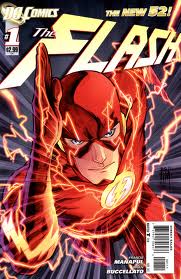 Bart’s costume as the Flash was a clone of his grandfather’s, similarly stylized to Wally West’s. Not long after taking the mantle of the Flash, Bart was killed by the Rogues in the 13th (and final) issue of The Flash: The Fastest Man Alive. However, he was later resurrected in the 31st century in Final Crisis: Legion of 3 Worlds #3 by Brainiac 5 to combat Superboy-Prime and the Legion of Super-Villains. Writer Geoff Johns confirmed that Bart will return to the past and play a large role in The Flash: Rebirth.
Bart’s costume as the Flash was a clone of his grandfather’s, similarly stylized to Wally West’s. Not long after taking the mantle of the Flash, Bart was killed by the Rogues in the 13th (and final) issue of The Flash: The Fastest Man Alive. However, he was later resurrected in the 31st century in Final Crisis: Legion of 3 Worlds #3 by Brainiac 5 to combat Superboy-Prime and the Legion of Super-Villains. Writer Geoff Johns confirmed that Bart will return to the past and play a large role in The Flash: Rebirth.
In the television series Smallville, Bart is a troubled teen who trades crime for money. After saving Clarks’ father though, Clark finds that there is good in him. After meeting Lex, Bart steals an important artifact that plays a big role in other episodes. But with Clark’s help, he gets Bart to change his ways. The Kent family was willing to adopt him, but he didn’t want to stay in Smallville. Bart is faster than Clark. They acquire a weird friendship, which we all know will lead him to be Flash and join the Justice League. On the series, of course, this Bart Allen would also become known as Impulse after foiling.
Others to carry the mantle of the Flash – Jesse Chambers
Daughter of the speedster Johnny Quick, Jesse Chambers becomes a speeding superhero like her father. She later meets Wally West, the Flash, who asks her to be his replacement if something were to happen to him (as part of an elaborate plan on his part, trying to force Bart Allen to take his role in the legacy of the Flash more seriously). She briefly assumes the mantle of the Flash, after Wally enters the Speed Force.
Unnamed Allen of the 23rd century
The father of Sela Allen, his wife and daughter were captured by Cobalt Blue. He is forced to watch his wife die and his daughter become crippled. As he and Max Mercury kill Cobalt Blue, a child takes the gem and kills Allen. This Flash is one of the two destined Flashes to be killed by Cobalt Blue.
Sela Allen
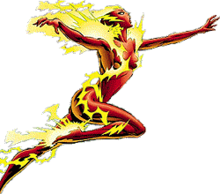 Sela Allen as the Flash of the 23rd century.
Sela Allen as the Flash of the 23rd century.
Sela Allen is an ordinary human in the 23rd century until Cobalt Blue steals electrical impulses away from her, causing her to become as slow to the world as the world is to the Flash. Hoping to restore her, her father takes her into the Speed Force. When her father is killed, she appears as a living manifestation of the Speed Force, able to lend speed to various people and objects, but unable to physically interact with the world.
Blaine Allen
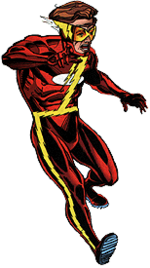 Blaine Allen as the Flash of the 28th century.
Blaine Allen as the Flash of the 28th century.
Blaine Allen and his son live on the colony world of Petrus in the 28th century. In an attempt to end the Allen blood line, Cobalt Blue injects Allen’s son Jace with a virus. Lacking super speed, Jace was unable to shake off the virus. In despair, Blaine takes his son to the Speed Force in the hopes that it would accept him. It takes Blaine instead and grants super speed to Jace so that he can shake off the sickness.
Jace Allen
Jace Allen gains super speed when his father brings him into the Speed Force to attempt to cure him of a virus injected into his body by Cobalt Blue in an attempt to end the Allen bloodline. In memory of his father, Jace assumes the mantle of the Flash and continues the feud against Cobalt Blue.
Kryad
After an alien creature invades Earth, a history buff named Kryad travels back in time from the 98th century to acquire a Green Lantern power ring. He fails, so he tries to capture the Flash’s speed instead. After being beaten by Barry Allen (The Flash (vol. 1) #309, May 1982), he travels back further in time and uses the chemicals from the clothes Barry Allen was wearing when he gained his powers. Kryad sacrifices his life to defeat the alien creature.
Bizarro Flash
Bizarro-Flash was created when Bizarro cloned Flash. He had a costume the reverse colors of Flash’s, however he had a gavel symbol because Flash was holding one when he was cloned. The modern version of Bizarro Flash has the symbol of a thunderbolt-shaped mustard stain.
Powers and abilities
 All incarnations of the Flash can move, think, and react at light speeds as well as having superhuman endurance that allows them to run incredible distances. Some, notably later versions, can vibrate so fast that they can pass through walls in a process called quantum tunneling, travel through time and can also lend and borrow speed. Furthermore, all members have an invisible aura around their bodies that prevents themselves and their clothes from being affected by air friction as they move at high speed. Speedsters can heal more rapidly than the average human.
All incarnations of the Flash can move, think, and react at light speeds as well as having superhuman endurance that allows them to run incredible distances. Some, notably later versions, can vibrate so fast that they can pass through walls in a process called quantum tunneling, travel through time and can also lend and borrow speed. Furthermore, all members have an invisible aura around their bodies that prevents themselves and their clothes from being affected by air friction as they move at high speed. Speedsters can heal more rapidly than the average human.
On several occasions, the Flash has raced against Superman, either to determine who is faster or as part of a mutual effort to thwart some type of threat; these races, however, often resulted in ties because of outside circumstances. Writer Jim Shooter and artist Curt Swan crafted the story “Superman’s Race With the Flash!” in Superman #199 (Aug. 1967) which featured the first race between the Flash and Superman. Writer E. Nelson Bridwell and artist Ross Andru produced “The Race to the End of the Universe”, a follow-up story four months later in The Flash #175 (Dec. 1967). However, after the DC Universe revision after Crisis on Infinite Earths, The Flash does successfully beat Superman in a race in Adventures of Superman #463 with the explanation that Superman is not accustomed to running at high speed for extended periods of time since flying is more versatile and less strenuous, which means the far more practiced Flash has the advantage. After Final Crisis in Flash: Rebirth #3 the Flash is shown as being much faster than Superman, easily outstripping him as Superman tries to keep up with him. He claims that all the close races between them had been “for charity.”
Speedsters may at times use the ability to speed-read at incredible rates and in doing so, process vast amounts of information. Whatever knowledge they acquire in this manner is usually temporary (Bart Allen seems to be the exception, though in earlier years, Max Mercury believed that Bart’s speed learning would not stick). Their ability to think fast also allows them some immunity to telepathy, as their thoughts operate at a rate too rapid for telepaths such as Martian Manhunter or Gorilla Grodd to read or influence their minds.
Flashes and other super-speedsters also have the ability to speak to one another at a highly accelerated rate. This is often done to have private conversations in front of non-fast people (as when Flash speaks to Superman about his ability to serve both the Titans and the JLA in The Titans #2). Speed-talking is also sometimes used for comedic effect where Flash becomes so excited that he begins talking faster and faster until his words become a jumble of noise (Wally West once became so surprised that he generated a small sonic boom with his voice). The Barry Allen version of the Flash was also known to be able to control lightning, though this was not an ability that he utilized often.
Other versions
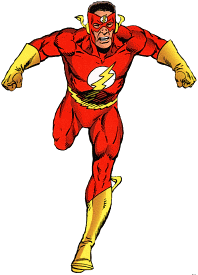 Tanaka Rei from Legends of the DC Universe: Crisis on Infinite Earths. Art by Paul Ryan and Bob McLeod.
Tanaka Rei from Legends of the DC Universe: Crisis on Infinite Earths. Art by Paul Ryan and Bob McLeod.
In the final issue of 52, a new Multiverse is revealed, originally consisting of 52 identical realities. Among the parallel realities shown is one designated “Earth-2.” As a result of Mister Mind “eating” aspects of this reality, it takes on visual aspects similar to the pre-Crisis Earth-2, including the Flash among other Justice Society of America characters. The names of the characters and the team are not mentioned in the panel in which they appear, but the Flash is visually similar to the Jay Garrick Flash. Based on comments by Grant Morrison, this alternate universe is not the pre-Crisis Earth-2.
A variant of the Flash – a superfast college student named Mary Maxwell – was seen in the Elseworld book Just Imagine Stan Lee Creating The Flash.
Tanaka Rei
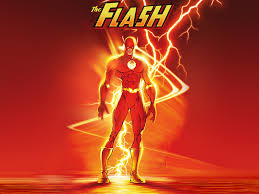 The Flash of Earth-D, Rei was a Japanese man who idolized Barry Allen, whose stories only existed in comic books on this world. Rei was inspired by Allen to become the Flash, much like Allen was inspired to become the Flash by his idol, Jay Garrick. Allen and Rei met during the “Crisis on Infinite Earths” when Barry was coming back from the 30th century and arrived in the wrong universe. As Earth-D was under attack by the shadow demons, Barry called on the Justice League and Tanaka called on the Justice Alliance, his world’s version of the Justice League. They built a cosmic treadmill and were able to evacuate much of Earth-D’s population. The Justice League left, but 39 seconds later, Earth-D perished.
The Flash of Earth-D, Rei was a Japanese man who idolized Barry Allen, whose stories only existed in comic books on this world. Rei was inspired by Allen to become the Flash, much like Allen was inspired to become the Flash by his idol, Jay Garrick. Allen and Rei met during the “Crisis on Infinite Earths” when Barry was coming back from the 30th century and arrived in the wrong universe. As Earth-D was under attack by the shadow demons, Barry called on the Justice League and Tanaka called on the Justice Alliance, his world’s version of the Justice League. They built a cosmic treadmill and were able to evacuate much of Earth-D’s population. The Justice League left, but 39 seconds later, Earth-D perished.
Rei made his only appearance in Legends of the DC Universe: Crisis on Infinite Earths (February 1999). The story was written by Marv Wolfman, with art by Paul Ryan (pencils) and Bob McLeod (ink).

